I held my hands in front of me as if in prayer, waiting for the speaker’s next words, on my first morning at the Greater Richmond Convention Center. I wasn’t alone; the others in the conference room sat in the same reverent position.
In front of us, the poet Allan Wolf told us to imagine that our closed palms were the book that we would write or would eventually occur to us. “Now open it with me and gasp in wonder,” Wolf said. All of us opened our hands in unison and gasped. The moment was punctuated by embarrassed laughter and nervous smiles to the people around us. But nonetheless, the 2012 James River Writers Conference began with a writer’s affirmation of faith in the act of creation.

After Wolf’s inspired introduction, we attending writers were quickly brought back to earth by practical matters. As a conference staple, the First Pages Critique presented the other, less uplifting side of writing — the revision process. Before the critique began, our moderator David L. Robbins stated, “The point of this is not to eviscerate or celebrate; the point is to teach.” Literary agents Ayesha Pande and Alec Shane, and editor Liz Bicknell weighed in on the merits and weaknesses of the submitted opening pages.
Bicknell stressed the importance of grabbing the reader on the first page, saying “You are the same writer on page one as you are on page 200. If you are a better writer by page 200, no one is going to know because they won’t have read that far.”After the opening session ended and I toured the Conference Marketplace, I headed over to the Literary Luncheon, held in one of the convention center’s large ballrooms. Here were more opportunities to not just connect with the conference speakers, but to chat with the finalists for the various Virginia Literary Awards being awarded by the Library of Virginia that Saturday night.
The most captivating moment of the luncheon, however, was the interview with Tom Robbins. After Robbins read from a personal artistic statement, he answered questions posed to him by Dean King. Many answers were cryptic but intriguing.
When asked what his goals were when writing, Robbins replied that he took guidance from Kafka’s quote, “A novel should be an ax for the frozen sea around us.” Robbins also revealed that when writing, he perfects each sentence he writes before moving onto the next. He only ever writes one draft. The rest of us murmured nervously, probably remembering just how difficult it was just to sit down at one’s desk. But, Robbins ended his interview with a soothing reminder, “Above all, have a good time because if you aren’t having fun writing it, people won’t enjoy reading it.”
After the whirlwind pace of the morning, I was ready for the panels that filled the rest of the afternoon. Remembering Liz Bicknell’s words, I first chose to attend a panel on self-editing and peer critiques, “Don’t Fight the Feedback.”
One of the interesting questions covered during the panel was the struggle of when to edit. During the writing process, a writer struggles to turn off the internal editor that inhibits creating the simplest sentence. However, once composing is complete, there are numerous opportunities to edit.
Cherise Fisher, a developmental editor, broke down the different types of editing for us. Each job examines specific parts of text, from copy editing (which corrects basic typos) to developmental editing (which fixes what Fisher called “big picture issues”—plot, structure, and characterization).
Dizzy with trying to store this valuable info, I walked into my next panel, “Insight Into Your Site.” Both older and younger people were present, all of them trying to figure out if they needed a blog or how exactly they should use it to boost their own writing career.

The panelists, who included Erin Blakemore, author of The Heroine’s Bookshelf; and Colleen Lindsay, community manager of BookCountry.com, emphasized that blogs are a platform for writers, a way to show off what they know. They outlined must-haves for an author’s website, including “good writing professionally presented,” “a front page with fresh content,” “basic contact info,” and “social media links for accounts you actively use.” Literary agent Anna Sproul said, “Authenticity is key,” stressing that social media provides an opportunity to have a conversation with like-minded readers.
These two panels were pretty matter-of-fact about the technical aspects of refining one’s writing and sharing it to others. So I was surprised when my next panel on creative nonfiction, a deceptively simple genre, became a discussion on truth and fact.
Author Jonathan Coleman gave the definition of creative nonfiction as a nonfiction story that satisfies the standards of truth as held up by academics but constructed in a specific stylistic fashion. But Anna Sproul admitted that there was really no way in the publishing industry of guaranteeing that a nonfiction work was 100 percent true before producing it. “It’s an act of faith in many ways,” she said.
Coleman, however, was a true believer in the saving grace of research and pinning down as many facts as one could. “I want to know,” he said, “I want to get as close to the truth of that story as possible.”
Writing, that vital act of creation, was the way to reconcile what felt true with what actually happened. With that final affirmation, my first day at the JRW conference ended.
— Elizabeth Rabin, JRW website contributor

Back to Conference News and Views page


